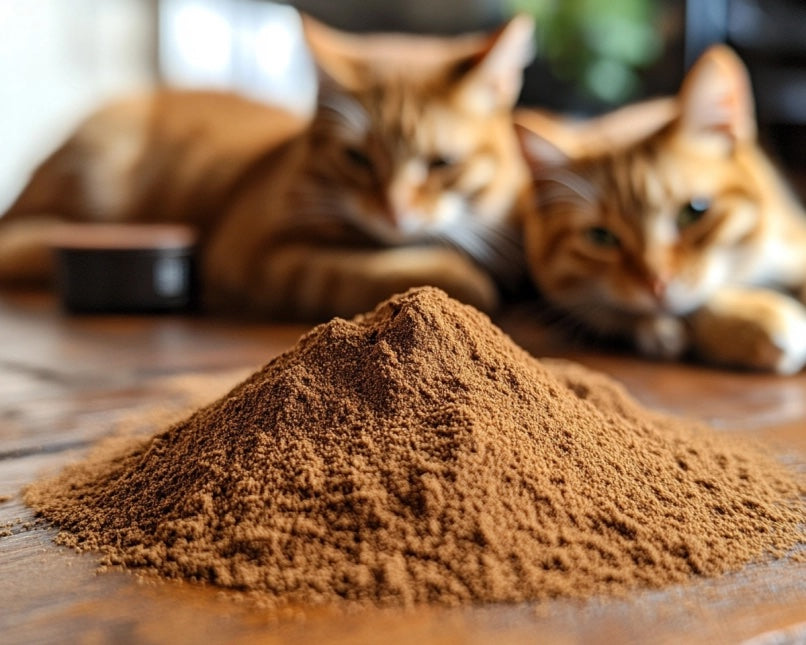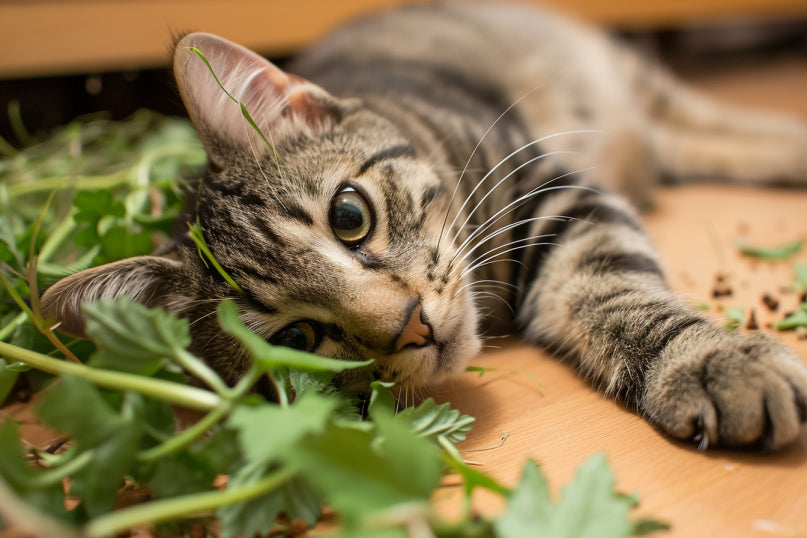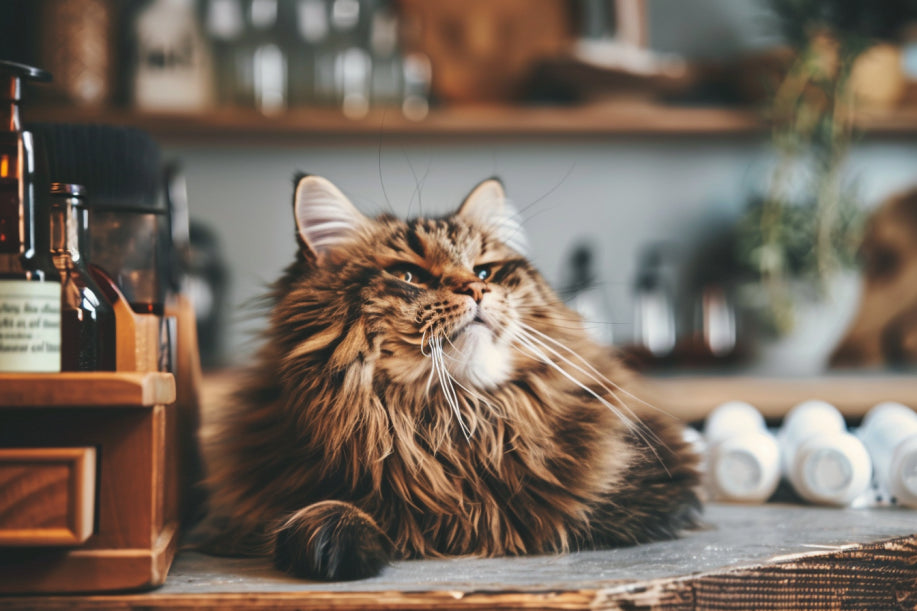
A massage with essential lavender oils may soothe your anxiety, beat away your blues, and improve the quality of your sleep. But is it safe to have lavender oil and lavender flowers around your cat?
Lavender is mildly toxic to cats, so be cautious when using it around your BFF.
We spoke with Amber LaRock, a licensed vet tech and animal welfare expert at Pet Worshiper, to find out what types of lavender are safest for your cat.
Table of Contents
What is lavender?Health Benefits of Lavender for Cats
Are dried lavender plants safe for cats?
Is lavender oil safe for cats?
Are lavender-scented products safe for cats?
Can I give my cat human lavender products?
Should I wear lavender products around my cat?
What should I do if my cat eats lavender?
Lavender Plant Profile
What is lavender?
Lavender is a flowering subshrub with violet-blue flowers and bluish-green to silver needles. Native to the Mediterranean region, lavender thrives in the blazing sun and dry sandy soils. Lavender grows 12-36 inches (30.48-91.44 centimeters) tall and wide. According to the University of California, lavender can live for 5-7 years.
Related to the mint family, lavender includes 39 different species with 450 varieties. The most common types of lavender are: English lavender, French lavender, and woolly lavender.
Health Benefits of Lavender for Cats
There’s limited research on the health benefits of lavender for cats.
Researchers at the University of Pisa used a blend of English and Portuguese lavender to treat ear infections in cats. Because lavender oil is antibacterial, it can be used as an alternative treatment for feline ear infections caused by fungi.
Veterinary nurses Samantha Goodwin and Helen Reynolds also used lavender aromatherapy to calm hospitalized felines. Cats were less stressed out by previous negative veterinary experiences and unfamiliar sounds and smells.
A 2010 study in the Journal of Applied Animal Behaviour Science found that certain scents enrich the lives of house cats. Researchers at the University of London gave 150 cats lavender, rabbit, and catnip-infused cloth. While they responded to the lavender-infused cloth, they had stronger reactions to the catnip and rabbit scents. They caused the indoor cats to actively explore their environment and experience deep sleep.
Are dried lavender plants safe for cats?

“Not all cats will react to lavender in the same way,” LaRock says. “Some may find the scent calming while others may be bothered by it.”
These pretty purple flowers contain toxic compounds called linalool and linalyl acetate. Your cat’s liver doesn’t have P450 cytochrome enzymes, so it can’t break down the components of lavender plants.
“If you have a fresh lavender plant, make sure the leaves are out of reach, so your cat doesn't nibble on them,” LaRock says. “Small amounts of fresh or dried lavender flowers rarely cause severe problems in cats.” Don’t want your kitty to have a belly ache? Stuff these bright purple blooms in a sachet pouch.
Is lavender oil safe for cats?
Lavender oil has a stronger smell than the lavender plants it comes from. This colorless or yellow liquid contains concentrated forms of linalool and linalyl acetate. That makes it more dangerous than fresh or dried lavender plants.
Diluted lavender oil is safe for your cat to breathe in, as long as she doesn't have asthma or other breathing problems. But you should never confine her to a room where lavender oil is being diffused. Make sure she can escape to another room to get away from the essential oil diffuser.
“Depending on the concentration of the lavender oil and how sensitive your cat is to strong smells, using lavender oil topically may cause skin irritation or even an allergic skin reaction,” LaRock says.
If lavender oil isn’t weakened with a carrier oil, it can cause your cat to have liver failure or chemical burns. "Your cat will also lick lavender off her body. This can have serious health consequences like breathing problems,” LaRock says. You shouldn’t let your cat lick lavender oil. It can burn her lips, gums, and tongue.
Researchers at the University of Arizona studied one of the main chemicals in lavender oil. Cats exposed to linalool had excessive drooling, muscle tremors, an uncoordinated gait, depression, and hypothermia.
Are lavender-scented products safe for cats?

Lavender-scented products are safe for cats. “Not all lavender products are created equal, and some may be more potent than others,” LaRock says. Err on the side of caution. Talk to your vet before using any new lavender products — especially if your cat has a history of allergies or sensitivities.
Can I give my cat human lavender products?
You should never use human lavender products on your cat. Lavender-based cat products like flea sprays have much lower concentrations of lavender than those made for humans.
Should I wear lavender products around my cat?
It depends on how much of the lavender product you’re wearing and how much it has been diluted. “Lavender hand lotion doesn’t have as many harmful substances that could be a problem for your cat, at least as far as inhalation is concerned,” LaRock says. “Avoid petting your cat if you have applied lavender-containing creams to your hands.” When your cat eats lavender skin products, it can cause nausea, vomiting, and loss of appetite.
What should I do if my cat eats lavender?

“If your cat eats lavender, induce vomiting at home by giving her hydrogen peroxide or salt water in small doses,” LaRock says. “They should only be used if the situation is complex and you can’t get to your vet in time.”
That’s because hydrogen peroxide can cause severe, life-threatening stomach ulcers. If your cat is a senior or has kidney disease, salt water can also result in kidney failure. Brachycephalic cats like British Shorthairs shouldn’t be forced to vomit. If your flat-faced cat breathes in her own vomit, it can cause the air sacs in her lungs to fill up with fluid or pus.
“When inducing vomiting, make sure that as much hydrogen peroxide or salt water as possible leaves your cat's body,” LaRock says. “After all this, take your cat to the nearest vet as soon as possible.”
Lavender Plant Profile
Lavender |
|
 |
|
|
Genus name |
Lavandula |
|
Most common species of lavender |
|
|
Comes from |
The Mediterranean |
|
Plant type |
Flowering subshrub |
|
Advantages |
🦋 Attracts butterflies 🐝 Bee-friendly  Deer-resistant Deer-resistant
✅ Fragrant flowers, stems, and leaves ✅ Good for cut and dried flowers 🌲 Evergreen |
|
Hardiness Zone |
🇺🇸 5-9 |
|
Sunlight |
☀️ Full sun |
|
Water Tolerance |
💧Low-Water |
|
Mature Height |
12-36" tall (31-92 cm) |
|
Mature Spread |
24-48" wide (61-122 cm) |
|
Bloom Time |
🌊Summer |


